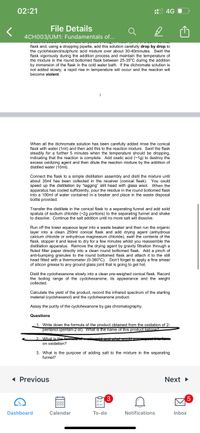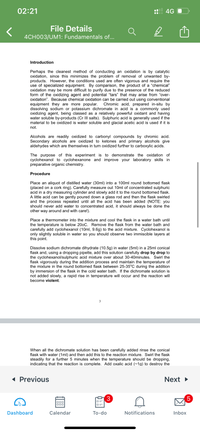
Chemistry
10th Edition
ISBN: 9781305957404
Author: Steven S. Zumdahl, Susan A. Zumdahl, Donald J. DeCoste
Publisher: Cengage Learning
expand_more
expand_more
format_list_bulleted
Concept explainers
Question

Transcribed Image Text:02:21
4G
File Details
4CH003/UM1: Fundamentals of...
flask and, using a dropping pipette, add this solution carefully drop by drop to
the cyclohexanol/sulphuric acid mixture over about 30-40minutes. Swirl the
flask vigorously during the addition process and maintain the temperature of
the mixture in the round bottomed flask between 25-35°C during the addition
by immersion of the flask in the cold water bath. If the dichromate solution is
not added slowly, a rapid rise in temperature will occur and the reaction will
become violent.
3
When all the dichromate solution has been carefully added rinse the conical
flask with water (1ml) and then add this to the reaction mixture. Swirl the flask
steadily for a further 5 minutes when the temperature should be dropping,
indicating that the reaction is complete. Add oxalic acid (~1g) to destroy the
excess oxidizing agent and then dilute the reaction mixture by the addition of
distilled water (10ml).
Connect the flask to a simple distillation assembly and distil the mixture until
about 35ml has been collected in the receiver (conical flask). You could
speed up the distillation by "lagging" still head with glass wool. When the
apparatus has cooled sufficiently, pour the residue in the round bottomed flask
into a 100ml of water contained in a beaker and place in the waste disposal
bottle provided.
Transfer the distillate in the conical flask to a separating funnel and add solid
spatula of sodium chloride (~2g portions) to the separating funnel and shake
to dissolve. Continue the salt addition until no more salt will dissolve.
Run off the lower aqueous layer into a waste beaker and then run the organic
layer into a clean 250ml conical flask and add drying agent (anhydrous
calcium chloride or anhydrous magnesium chloride), swirl the contents of the
flask, stopper it and leave to dry for a few minutes whilst you reassemble the
distillation apparatus. Remove the drying agent by gravity filtration through a
fluted filter paper directly into a clean round bottomed flask. Add a pinch of
anti-bumping granules to the round bottomed flask and attach it to the still
head fitted with a thermometer (0-360°C). Don't forget to apply a fine smear
of silicon grease to any ground glass joint that is going to get hot.
Distil the cyclohexanone slowly into a clean pre-weighed conical flask. Record
the boiling range of the cyclohexanone, its appearance and the weight
collected.
Calculate the yield of the product, record the infrared spectrum of the starting
material (cyclohexanol) and the cyclohexanone product.
Assay the purity of the cyclohexanone by gas chromatography.
Questions
1. Write down the formula of the product obtained from the oxidation of 2-
pentanol (pentan-2-ol). What is the name of this product ketone2
What is the fermur
velio ecidenduh
on oxidation?
3. What is the purpose of adding salt to the mixture in the separating
funnel?
1 Previous
Next
3
000
Dashboard
Calendar
То-do
Notifications
Inbox
LO

Transcribed Image Text:02:21
4G
File Details
4CH003/UM1: Fundamentals of...
Introduction
Perhaps the cleanest method of conducting an oxidation is by catalytic
oxidation, since this minimizes the problem of removal of unwanted by-
products. However, the conditions used are often vigorous and require the
use of specialized equipment. By comparison, the product of a "chemical"
oxidation may be more difficult to purify due to the presence of the reduced
form of the oxidizing agent and potential "tars" that may arise from "over-
oxidation". Because chemical oxidation can be carried out using conventional
equipment they are more popular.
dissolving sodium or potassium dichromate in acid is a commonly used
oxidizing agent, being classed as a relatively powerful oxidant and having
water soluble by-products (Cr III salts). Sulphuric acid is generally used if the
material to be oxidized is water soluble and glacial acetic acid is used if it is
Chromic acid, prepared in-situ by
not.
Alcohols are readily oxidized to carbonyl compounds by chromic acid.
Secondary alcohols are oxidized to ketones and primary alcohols give
aldehydes which are themselves in turn oxidized further to carboxylic acids.
The purpose of this experiment is to demonstrate the oxidation of
cyclohexanol to cyclohexanone and improve your laboratory skills in
preparative organic chemistry.
Procedure
Place an aliquot of distilled water (30ml) into a 100ml round bottomed flask
(placed on a cork ring). Carefully measure out 10ml of concentrated sulphuric
acid in a dry measuring cylinder and slowly add it to the round bottomed flask.
A little acid can be gently poured down a glass rod and then the flask swirled
and the process repeated until all the acid has been added (NOTE: you
should never add water to concentrated acid, it should always be done the
other way around and with care!).
Place a thermometer into the mixture and cool the flask in a water bath until
the temperature is below 200C. Remove the flask from the water bath and
carefully add cyclohexanol (10ml, 9.6g) to the acid mixture. Cyclohexanol is
only slightly soluble in water so you should observe two immiscible layers at
this point.
Dissolve sodium dichromate dihydrate (10.5g) in water (5ml) in a 25ml conical
flask and, using a dropping pipette, add this solution carefully drop by drop to
the cyclohexanol/sulphuric acid mixture over about 30-40minutes. Swirl the
flask vigorously during the addition process and maintain the temperature of
the mixture in the round bottomed flask between 25-35°C during the addition
by immersion of the flask in the cold water bath. If the dichromate solution is
not added slowly, a rapid rise in temperature will occur and the reaction will
become violent.
3
When all the dichromate solution has been carefully added rinse the conical
flask with water (1ml) and then add this to the reaction mixture. Swirl the flask
steadily for a further 5 minutes when the temperature should be dropping,
indicating that the reaction is complete. Add oxalic acid (~1g) to destroy the
1 Previous
Next
3
000
Dashboard
Calendar
То-do
Notifications
Inbox
LO
Expert Solution
This question has been solved!
Explore an expertly crafted, step-by-step solution for a thorough understanding of key concepts.
This is a popular solution
Trending nowThis is a popular solution!
Step by stepSolved in 2 steps with 1 images

Knowledge Booster
Learn more about
Need a deep-dive on the concept behind this application? Look no further. Learn more about this topic, chemistry and related others by exploring similar questions and additional content below.Similar questions
- What is the pH of the sodium lactate solution? C3H5O3 + H₂O HC3H5O3 + OH- [C3H5O3] = 3.22 x 10-¹ M Ka(HC3H503) = 1.38 x 10-4 pH = [?] pH of NaC₂H₂O Enterarrow_forwardmmol of 1,3-dibenzoylpropane used to 4 sig. fig Used: 405 mg molecular weight: 252.31 g/molarrow_forwardCH3OH+CH3CH2CH2OH+H2SO4/140degresarrow_forward
- Paused Complete the following reactions. 1. +H₂O NaBH mild oxidation Complete the following reactions. 1. Base cat. H3CH2C CH₂CH + H3CH2C- C -CH2CH3 2. OCH3 H3C-C -CH2CH3 + H₂O OCH3 3. 4. CH3 NaBH4 H3CH2C C CH2CH3 + CH3CH2OH 5. mild oxidationarrow_forwardCurrent Attempt in Progress Consider the following "road map" problem. A (C5H8) F G Br₂, warm (1 molar equiv.) CH₂ONa (2 molar equiv.) HBr (no ROOR) CH CH₂ CH3 CH3 + B (C9H10) MCPBA (or RCO₂H) "C6H5 C6H5 NaOEt, heat (+ corresponding 1,4-dimethyl-2-phenyl isomers) E NBS, ROOR, heat D (C,H12) H OH KOC(CH3)3, heat OCH3 I reagents? (C7H₁402) OCH3 Elucidate the structure of compound G. Draw Your Solutionarrow_forward4) Why might a student obtain a percent yield more than 100% for this preparation?arrow_forward
- please answer all parts , thank you :)arrow_forwardntrol 5. ! 1 F1 Q A Below is a primary alcohol or and an aldehyde (of same carbon length). Which is more likely to be soluble in water? Explain. 2 Z option I F2 W S # 3 80 F3 X дв command E $ 4 C F4 R OH % 5 F5 V T G MacBook Air ^ 6 F6 Y B & 7 H 44 F7 U N * 8 J DII FB I M ( 9 K DD F9 0 < I مو H ) 0 L command v F10 P ^. O - ... I option F11 { [ ? 1 + 11 11 I 41) F12 } 1 delarrow_forwardPlease explainarrow_forward
- C. Lit¹ [(CH),Cu], ether H-2 d. one to CH3(CO)CL, AICI CS2 (solvent) H pub ant to botto slings/quapoint to 200arrow_forwardWhich of the following will NOT be soluble in water? CH3 A. H3C-CH-CH2-CH2 В. H3C-CH2-CH2- С. D. All of the above OA Structure A only O B. Structure B only OC.Structure Conly OD. All three structures (A, B, C) are not water solublearrow_forwardWhich of the following, A, B, C, did you use to dry a solution of organie in an organic solvent such as diethyl ethert The answer may be just one of them, any two of them or all three. A: Magnesium Sulfate B: Amberlyst 15 C: Sodium Hydroxide O AB, and C O A and C O Band C A only O B only O Conlyarrow_forward
arrow_back_ios
SEE MORE QUESTIONS
arrow_forward_ios
Recommended textbooks for you
 ChemistryChemistryISBN:9781305957404Author:Steven S. Zumdahl, Susan A. Zumdahl, Donald J. DeCostePublisher:Cengage Learning
ChemistryChemistryISBN:9781305957404Author:Steven S. Zumdahl, Susan A. Zumdahl, Donald J. DeCostePublisher:Cengage Learning ChemistryChemistryISBN:9781259911156Author:Raymond Chang Dr., Jason Overby ProfessorPublisher:McGraw-Hill Education
ChemistryChemistryISBN:9781259911156Author:Raymond Chang Dr., Jason Overby ProfessorPublisher:McGraw-Hill Education Principles of Instrumental AnalysisChemistryISBN:9781305577213Author:Douglas A. Skoog, F. James Holler, Stanley R. CrouchPublisher:Cengage Learning
Principles of Instrumental AnalysisChemistryISBN:9781305577213Author:Douglas A. Skoog, F. James Holler, Stanley R. CrouchPublisher:Cengage Learning Organic ChemistryChemistryISBN:9780078021558Author:Janice Gorzynski Smith Dr.Publisher:McGraw-Hill Education
Organic ChemistryChemistryISBN:9780078021558Author:Janice Gorzynski Smith Dr.Publisher:McGraw-Hill Education Chemistry: Principles and ReactionsChemistryISBN:9781305079373Author:William L. Masterton, Cecile N. HurleyPublisher:Cengage Learning
Chemistry: Principles and ReactionsChemistryISBN:9781305079373Author:William L. Masterton, Cecile N. HurleyPublisher:Cengage Learning Elementary Principles of Chemical Processes, Bind...ChemistryISBN:9781118431221Author:Richard M. Felder, Ronald W. Rousseau, Lisa G. BullardPublisher:WILEY
Elementary Principles of Chemical Processes, Bind...ChemistryISBN:9781118431221Author:Richard M. Felder, Ronald W. Rousseau, Lisa G. BullardPublisher:WILEY

Chemistry
Chemistry
ISBN:9781305957404
Author:Steven S. Zumdahl, Susan A. Zumdahl, Donald J. DeCoste
Publisher:Cengage Learning

Chemistry
Chemistry
ISBN:9781259911156
Author:Raymond Chang Dr., Jason Overby Professor
Publisher:McGraw-Hill Education

Principles of Instrumental Analysis
Chemistry
ISBN:9781305577213
Author:Douglas A. Skoog, F. James Holler, Stanley R. Crouch
Publisher:Cengage Learning

Organic Chemistry
Chemistry
ISBN:9780078021558
Author:Janice Gorzynski Smith Dr.
Publisher:McGraw-Hill Education

Chemistry: Principles and Reactions
Chemistry
ISBN:9781305079373
Author:William L. Masterton, Cecile N. Hurley
Publisher:Cengage Learning

Elementary Principles of Chemical Processes, Bind...
Chemistry
ISBN:9781118431221
Author:Richard M. Felder, Ronald W. Rousseau, Lisa G. Bullard
Publisher:WILEY